November 22, 2021
For the first time, the college where I work gave us the entire week of Thanksgiving off. Bob and I just couldn't pass up that opportunity. We started planning a trip to Nashville, but then Covid numbers in that area started looking bad, and most of the places we wanted to go were inside. Where could we go that was less crowded and had more outdoor attractions?
Why, Texas, of course! After all, we had never been to the Texas Gulf Coast!!
To say I wasn't very excited about our new plan was an understatement. Bob booking a flight that left at 6:05 AM from Palm Springs didn't do much to increase my excitement. I got up at 2:30 AM and we left for the airport at 3:30.
Our flight was uneventful and we arrived in Houston around 11:00 Central Time, picked up a Mitsubishi rental car at Budget, and got on our way.
We headed for the lovely town of Beaumont, Texas, which turned out to be full of surprises. But then, just about every place we have ever traveled to has been full of surprises of some kind.
The first surprise was so wonderful that I'm going to give it its own post. St. Anthony's Cathedral Basilica has to be one of the most beautiful churches we've seen in Texas, and maybe even in the United States.
 |
| The exterior was being spray-washed when we visited. |
St. Anthony of Padua was a Franciscan friar who lived from 1195 to 1231 and was one of the most quickly canonized saints in church history. He is said to have had a mystical experience during which he held the Christ Child in his arms, which is why he is often shown holding the infant Jesus, as in the statue on the roof ridge.
The church was dedicated in 1907, given cathedral status in 2004, and elevated to a Minor Basilica in 2006 by Pope Benedict XVI.
St. Anthony is also known for his love and care for the poor.
Apostles in the windows. I think this is James and Andrew.
A side view:
We finally figured out that we had to go to the parish office to have a staffer unlock the door for us. When we stepped inside, we were met by a rich array of colors and curves. It is definitely a *gasp* interior! For most of our visit, we were the only people inside, so it was easy to take all the pictures we wanted. (Sorry, not sorry for the overload.) This is looking towards the altar:
Small chapels flank the altar. One is dedicated to the risen Christ:
Right: The presentation of the infant Jesus in the temple in Jerusalem; Left: Mary and Joseph find Jesus teaching in the temple.
I especially love the series of brass doors that depict the life of Jesus. They look very European.
Close-up of Jesus feeding the 5,000 with five loaves of bread and two fishes:
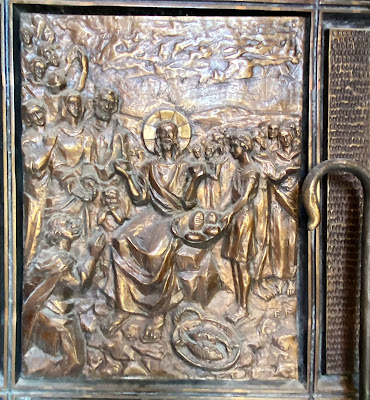 |
| Note the shepherd's staff door handle. |
Close-up of four of the six panels on the crucifixion doors.
Tender "Good Shepherd" sculpture:
The interior of the main dome:
A ciborium, or canopy, stands over the altar, which is on a raised dais.
A second, smaller dome behind the altar:
The Trinity, represented by three circles, is at the top of the smaller dome, and just below it is a crucifix set into the mosaic wall.
From the center of the nave looking towards the front . . . and the back:
The umbraculum (or "big umbrella") identifies this as a basilica.
A mosaic design representing the Trinity is inlaid in the floor in front of this chapel.
Another chapel honors the Virgin Mary, depicted here as the Virgin of Guadalupe:
There are angels everywhere.
Part of the joyous color of the Cathedral Basilica comes from exquisite stained glass windows. Some honor the church's namesake, St. Anthony:
Others depict the life of Jesus. The Annunciation gets a large round window:
Other scenes are in the traditional rectangular form. Since they are laid out counterclockwise, you need to view from right to left. Right: Mary and Elizabeth; Left: the Nativity.
Other scenes for the ministry of Jesus are made in a different style by different artists:
Just about every cathedral has a series of paintings, sculptures, or carvings for the Stations of the Cross. The series at St. Anthony's was especially beautiful.
I recently learned that crosses used for executions were not very high off the ground, so the shorter cross depicted in stations XII and XIII is probably more historically accurate that what we usually see.
Another beautiful inland mosaic in the floor represents the loaves and fishes.
At the rear of the nave are two wooden cabinets that might be confessionals, but I can't remember.
Each one has a tender bas relief wood carving on the glass door. On the left is a tribute to the Chinese, Native American, and immigrant Catholics, and on the right is a depiction of the peasant Juan Diego revealing the image of the Virgin of Guadalupe in his cloak.
I like baptismal fonts that are low and large enough to stand in. They aren't deep enough for an immersive baptism, but they would work better for baptizing an adult rather than an infant, which I am guessing is what they are used for. (Note the Stations of the Cross in the background between stained glass windows.)
Last but not least are two saints in their own special niches and holding the symbols of their ministry. St. Peter holds two keys, one gold and one silver. The gold represents his spiritual authority, or the power to bind and loose in heaven, and the silver represents his temporal authority, or the power to bind and loose on earth.
St. Paul holds a book that represents his epistles in the New Testament and the sword that foreshadows his martyrdom by beheading.
Well, that was nice! What else could Beaumont have in store for us?













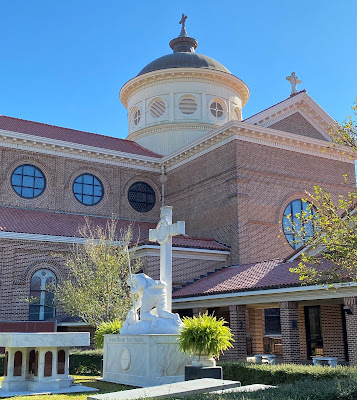












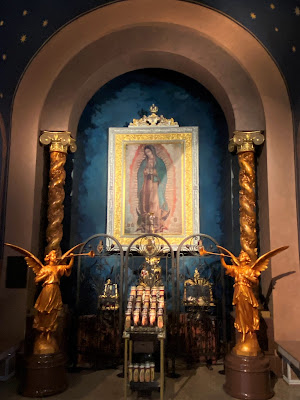





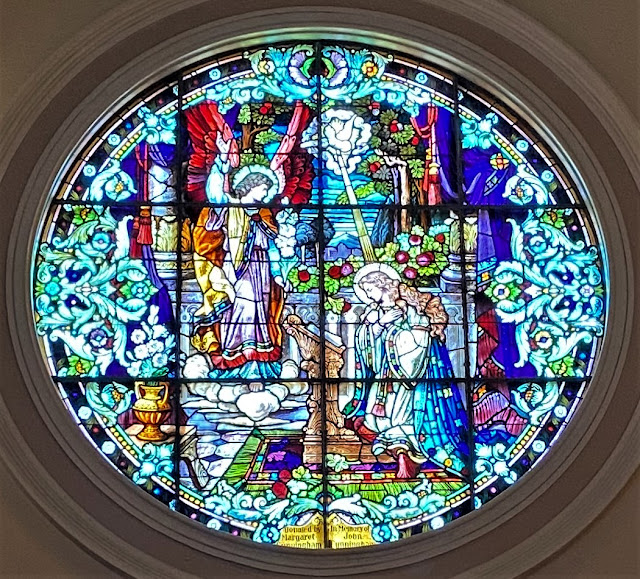






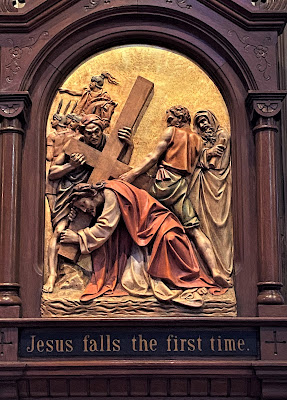




















Whew, I'm glad you liked something in Texas. This church is a gem. I've not heard of the gold and silver keys of Peter, that's a fun insight.
ReplyDeleteAlso, I love the Stations of the Cross.
ReplyDelete